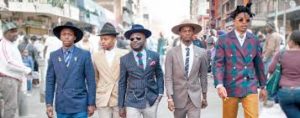December 2nd, 2022
It’s odd to imagine a group of people dressed in bright colors and designer brands skipping through impoverished streets, but if you’re visiting Kinsasha or Brazzaville, that might be what you see. Le Société des Ambianceurs et des Personnes Élégantes, or SAPE for short, is a community in the Democratic Republic of The Congo and the Republic of Congo that seeks to fight the hopelessness of poverty with style and optimism.
History
SAPE’s roots can be traced back to the French colonisation of the congolese. French men would give their old clothes to their congolese servants, in an effort to ‘civilise’ the people of the Congo. The young men who received these clothes were soon captivated by them, and used their coloniser’s French connection to spend whatever little money they had on the latest fashions in Europe. Over time, they made the style their own.
In the 1930s, Camille Diata was the face of SAPE in Brazzaville, but also a part of L’Amicale, an anti colonial movement. This connection between SAPE and political revolution remained even after French withdrawal from the Congo. In the 1970s, a Congolese musician named Papa Wemba is credited with the revival of SAPE, after emphasising the importance of well-dressed Congolese men in his public appearances and music. He also kept SAPE’s political aspects, changing it to a protest of the then current government’s banning of all things European and American.
Fashion
SAPE fashion itself is characterised by designer European brands, bright colours, and well-matched outfits. Sapeurs are called to be well dressed inside and out, in a fashion similar to European dandies, so a true Sapeur has to be kind, peaceful, and positive. Despite the popularity of the style in the Congo, you are unlikely to see a Sapeur in Canada. This is because in order to keep the aspects of protests against poverty and totalitarian government the flaunting of wealth has to be against a backdrop of Congolese destitution.
Controversy
Even though their fashion is extravagant, Sapeurs are ordinary people. The Republic of Congo and the Democratic Republic of the Congo are not rich countries, and the majority of their citizens are in poverty. Pretty clothes are wonderful until you have to pick between a designer tie and food or shelter, or school for your children. For many Sapeurs, even this is not an option. Many simply can’t make the required money, and resort to illegal means to fund their obsession with European fashion.
SAPE Today
Despite these controversies, SAPE continues to be a source of positivity and togetherness for many Congolese people, and allows the younger generation to be a part of something bigger than themselves, something that connects them to the world in a community that is far too often left behind.
By Moss Bondy
Categories: Fashion











